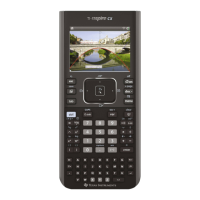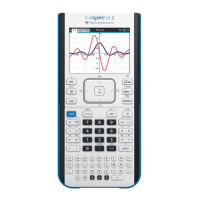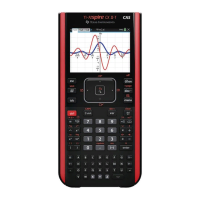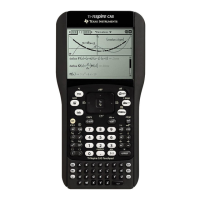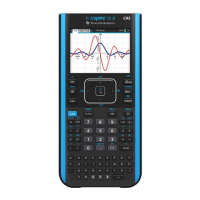TI-Nspire™ Reference Guide 103
tCdf()
Catalog
>
tCdf(lowBound,upBound,df) ⇒ number if lowBound and
upBound are numbers, list if lowBound and upBound are lists
Computes the Student-t distribution probability between lowBound
and upBound for the specified degrees of freedom df.
For P(X
{ upBound), set lowBound = .9E999.
Text
Catalog
>
Text promptString [, DispFlag]
Programming command: Pauses the program and displays the
character string promptString in a dialog box.
When the user selects OK, program execution continues.
The optional flag argument can be any expression.
•If DispFlag is omitted or evaluates to 1, the text message is
added to the Calculator history.
•If DispFlag evaluates to 0, the text message is not added to the
history.
If the program needs a typed response from the user, refer to
Request, page 83, or RequestStr, page 84.
Note: You can use this command within a user-defined program but
not within a function.
Define a program that pauses to display each of five random
numbers in a dialog box.
Within the Prgm...EndPrgm template, complete each line by
pressing @ instead of ·. On the computer keyboard,
hold down Alt and press Enter.
Define text_demo()=Prgm
For i,1,5
strinfo:=”Random number “ & string(rand(i))
Text strinfo
Next
EndPrgm
Run the program:
text_demo()
Sample of one dialog box:
Then See If, page
45
.
tInterval
Catalog
>
tInterval List[,Freq[,CLevel]]
(Data list input)
tInterval v,sx,n[,CLevel]
(Summary stats input)
Computes a t confidence interval. A summary of results is stored in
the stat.results variable. (See page 97.)
For information on the effect of empty elements in a list, see “Empty
(void) elements” on page 131.
Output variable Description
stat.CLower, stat.CUpper Confidence interval for an unknown population mean
stat.x
Sample mean of the data sequence from the normal random distribution
stat.ME Margin of error
stat.df Degrees of freedom
stat.sx
Sample standard deviation

